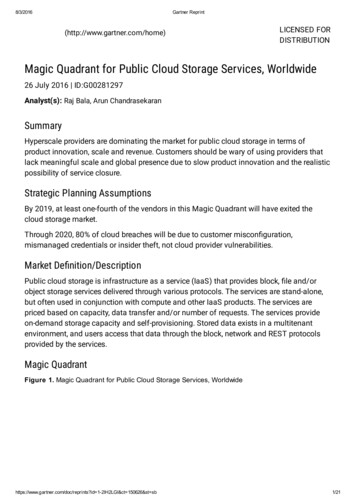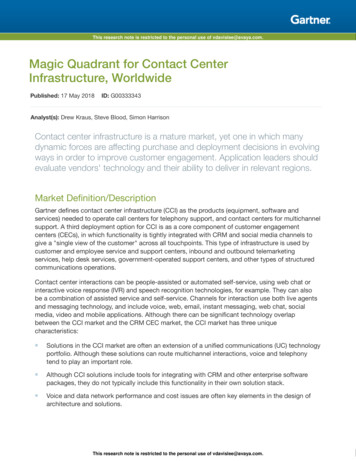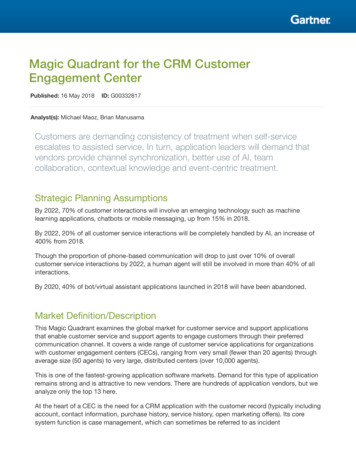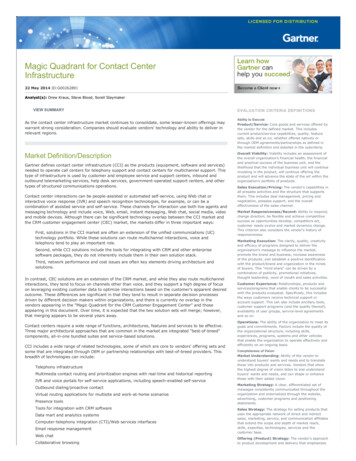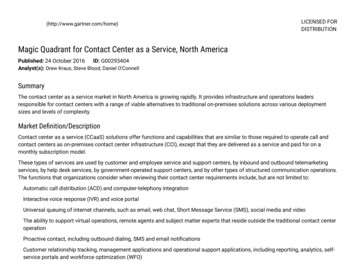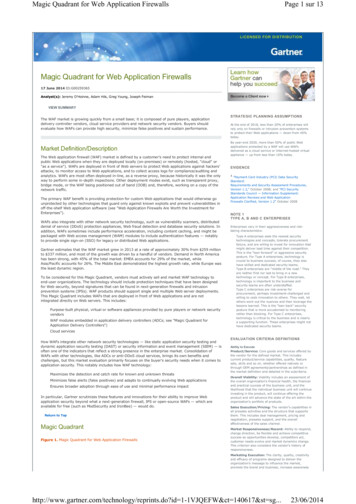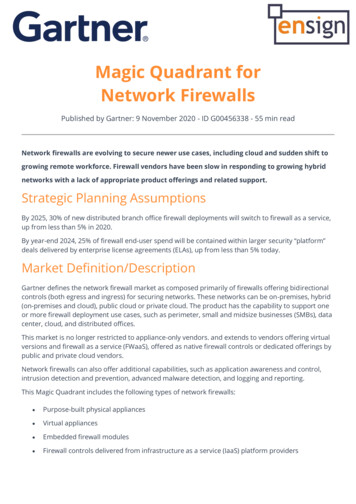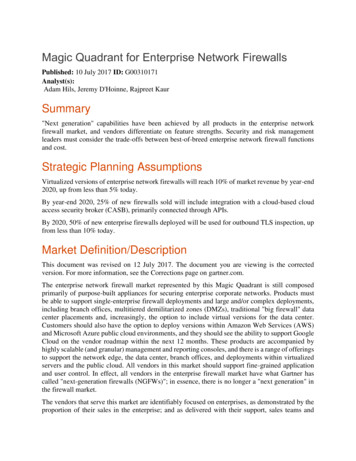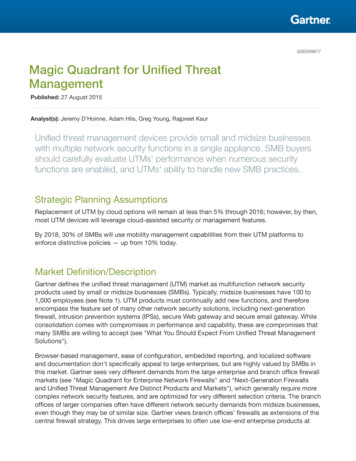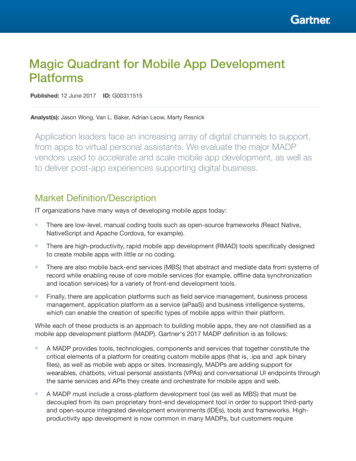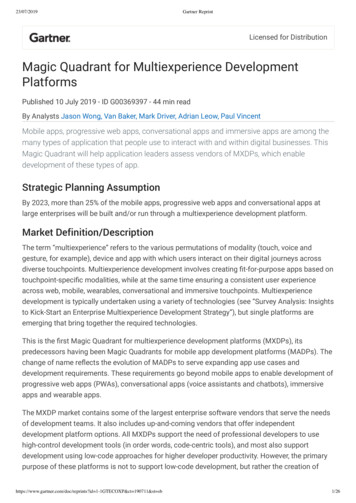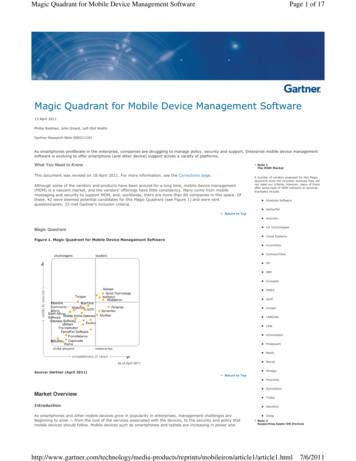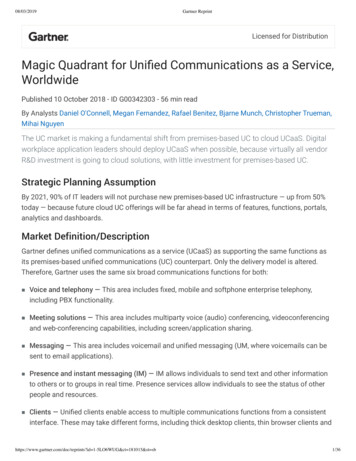
Transcription
08/03/2019Gartner ReprintLicensed for DistributionMagic Quadrant for Unified Communications as a Service,WorldwidePublished 10 October 2018 - ID G00342303 - 56 min readBy Analysts Daniel O'Connell, Megan Fernandez, Rafael Benitez, Bjarne Munch, Christopher Trueman,Mihai NguyenThe UC market is making a fundamental shift from premises-based UC to cloud UCaaS. Digitalworkplace application leaders should deploy UCaaS when possible, because virtually all vendorR&D investment is going to cloud solutions, with little investment for premises-based UC.Strategic Planning AssumptionBy 2021, 90% of IT leaders will not purchase new premises-based UC infrastructure — up from 50%today — because future cloud UC offerings will be far ahead in terms of features, functions, portals,analytics and dashboards.Market Definition/DescriptionGartner defines unified communications as a service (UCaaS) as supporting the same functions asits premises-based unified communications (UC) counterpart. Only the delivery model is altered.Therefore, Gartner uses the same six broad communications functions for both: Voice and telephony — This area includes fixed, mobile and softphone enterprise telephony,including PBX functionality. Meeting solutions — This area includes multiparty voice (audio) conferencing, videoconferencingand web-conferencing capabilities, including screen/application sharing. Messaging — This area includes voicemail and unified messaging (UM, where voicemails can besent to email applications). Presence and instant messaging (IM) — IM allows individuals to send text and other informationto others or to groups in real time. Presence services allow individuals to see the status of otherpeople and resources. Clients — Unified clients enable access to multiple communications functions from a consistentinterface. These may take different forms, including thick desktop clients, thin browser clients andhttps://www.gartner.com/doc/reprints?id 1-5LO6WUG&ct 181015&st sb1/36
08/03/2019Gartner Reprintclients for mobile devices, such as smartphones and tablets, as well as specialized clientsembedded within business applications. Communications-enabled business processes — The ability to integrate the UC solution with thebroader work and business application context offers significant value. Integration options includecontact centers, ChatOps/workgroup applications, workstream collaboration, plug-in integrationsfor leading business applications and browsers, communications platform as a service (cPaaS) fordigital business application integrations, and integration with business analytics and artificialintelligence (AI) capabilities.There are two types of UCaaS cloud delivery architectures: multitenant and multi-instance. Botharchitectures possess the standard cloud characteristics of shared infrastructure (for example, datacenters, racks, common equipment and blades), shared tools (for example, provisioning, performanceand network management tools), per-user-per-month pricing, and elasticity to dynamically add andsubtract users.However, in the multitenant version, all customers share a common (single) software instance, whilein the multi-instance architecture, each customer receives its own software instance. The advantageof multitenant is that it is easier for the vendor to maintain, build and upgrade users when they are onthe same software instance. In contrast, the advantage of multi-instance is that it allowscustomization to the needs of each organization, which is often favored by large customers.Today, virtually all UCaaS vendors are embracing a multitenant, microservices, infrastructure as aservice (IaaS) architecture in some form. In many cases, the applications reside in a public IaaScloud, with the media running in traditional data centers. These platforms are built, operated andupgraded by the UCaaS vendor in public cloud data centers (such as Amazon Web Services [AWS],Azure and Google Compute Engine), as opposed to a data center controlled by a communicationsservice provider (CSP) or system integrator (SI). This includes the megavendors like Cisco, Googleand Microsoft, as well as applications specialists like 8x8, Fuze and RingCentral. In the past twoyears, the market has witnessed better management tools with UCaaS offerings. They include ITadministration portals, usage dashboards, network performance portals and onboarding tools. Thesetools are particularly effective in identifying and remedying service quality issues. They are alsoeffective in enhancing the overall user experience of large customers, particularly those with sitesspread across the globe.Magic QuadrantFigure 1. Magic Quadrant for Unified Communications as a Service, Worldwidehttps://www.gartner.com/doc/reprints?id 1-5LO6WUG&ct 181015&st sb2/36
08/03/2019Gartner ReprintSource: Gartner (October 2018)Vendor Strengths and Cautions8x88x8 is a publicly held UCaaS application specialist. In 1Q18, 8x8 rebranded its product portfolio to theX Series, positioning 8x8 as a communications cloud portfolio with integrated UC, contact center,workstream collaboration, meetings (video) and analytics. This includes a role-based, mix-and-matchpricing menu for quick procurement. In 2Q18, 8x8 acquired machine learning startup MarianaIQ todeliver contextual personalization for omnichannel services.https://www.gartner.com/doc/reprints?id 1-5LO6WUG&ct 181015&st sb3/36
08/03/2019Gartner Reprint8x8’s roots are in the U.S. small and midsize business (SMB) market. Over the past five years, 8x8 hastargeted larger accounts, along with selected European and Asia/Pacific accounts. It now states thatover one-third of its user base is for enterprises above 1,000 seats. The company leverages a blendof both direct sales and channel partners for reaching new accounts. 8x8 has a Positive financialrating based on Gartner’s financial assessment tool (see Note 1).The majority of 8x8 customers are connected via the internet as opposed to Internet Protocol (IP)Multiprotocol Label Switching (MPLS). 8x8 continues to invest in automation tools for customer selfservice installations. For large customers above 3,000 seats, there is the Elite Touch program toprovide a structured project management methodology. Notable certifications supported include U.S.Health Insurance Portability and Accountability Act (HIPAA), Payment Card Industry (PCI) and EUGeneral Data Protection Regulation (GDPR).8x8 is well-positioned for both SMBs and enterprises in the 1,000- to 5,000-seat range, especiallythose seeking integrated contact center as a service (CCaaS). This includes businesses withheadquarters in North America, and selected European and Asia/Pacific country markets.Strengths 8x8 has a track record of successful deployments in the 1,000- to 5,000-seat enterprise market. Gartner believes that well over 50% of 8x8 customers purchase 8x8 CCaaS to complement theirUCaaS deployments. The 8x8 CCaaS has such capabilities as omnichannel, interactive voiceresponse (IVR) and quality management, and is well-integrated with UCaaS. The 8x8 platform received multiple enhancements in the year including the IT administrationportal, user interface, WebRTC video, workstream collaboration and enhanced analytics. Customers cite 8x8’s pricing as competitive and a good value for the array of capabilities provided.It is also easy to manage once up and running.Cautions 8x8 lacks a strong brand with enterprises, especially businesses over 2,500 seats. Manyenterprises never even consider 8x8 as a UCaaS option. The video/meeting capability is insufficient for formal meetings with business partners andexecutives. It is, however, good for internal usage and informal external communications. The 8x8 X Series contact center offerings are insufficient for some customers relative to reporting,workforce management and omnichannel integrations. Some customers report dissatisfaction with technical support and onboarding.https://www.gartner.com/doc/reprints?id 1-5LO6WUG&ct 181015&st sb4/36
08/03/2019Gartner ReprintAT&TAT&T is a global CSP. Sales are led by a direct-sales force and complemented by channel partners(the Alliance program) targeting the SMB market. There are three AT&T cloud-based UCaaS offers,which AT&T augments via best-of-breed integration, professional services and project management.The first, AT&T Collaborate, is part of the AT&T Integrated Cloud (AIC) architecture that leveragesnetwork function virtualization (NFV) and software-defined networking (SDN) capabilities and istypically deployed as an over-the-top (OTT) service. Over the past 12 months, AT&T launchedEnhanced Mobile, a voice over Long Term Evolution (VoLTE) native service that provides enterprisetelephony capabilities to mobile devices. AT&T has a Positive financial rating based on Gartner’sfinancial assessment tool (see Note 1).The second AT&T UCaaS offer is part of the Cisco Webex portfolio (formerly branded Cisco HostedCollaboration Solution [HCS]), and also includes Webex Calling, Webex Meetings and Cisco Jabber.This solution is hosted in georedundant AT&T data centers located in North America, Europe andAsia/Pacific, with service available in over 150 countries. The third cloud UC offer, Microsoft Skypefor Business with AT&T, is suited for organizations with a Microsoft UCaaS strategy.AT&T’s UCaaS solutions suit businesses ranging from SMBs to very large enterprises — oftenbundled with AT&T network services — that seek AT&T Collaborate (U.S. and Mexico), Cisco orMicrosoft technology. Most AT&T UCaaS accounts have a base of users in North America.Strengths AT&T UCaaS customers value the firm’s financial stability, mobile networks (U.S. and Mexico),global network coverage, and security services. AT&T offers three UCaaS solution options enabling the company to fulfill the UC requirements ofmost small to very large enterprises. Enterprise customers value AT&T’s dedicated account and project management teams, particularlyin the deployment phase. AT&T has made enhancements to simplify and improve the customer experience with a newupfront requirement design team, automated migration tools and postsales deployment services.Cautions AT&T can be slow to upgrade its UCaaS platforms to latest releases, in part due to AT&Tsupporting multiple UCaaS platforms (including Cisco, Microsoft and legacy BroadSoft) and theassociated regression testing efforts to ensure service quality. AT&T may struggle to differentiate itself from competitors as the UCaaS vendors — namely Cisco(BroadSoft) and Microsoft — increasingly run and control the UCaaS application stack, as opposedhttps://www.gartner.com/doc/reprints?id 1-5LO6WUG&ct 181015&st sb5/36
08/03/2019Gartner Reprintto running the stack in AT&T-controlled data centers. The AT&T Collaborate offering is available in the U.S. only. Furthermore, IT administration portalsacross its UCaaS solutions are English-only. Customers cite complexities with the Cisco HCS VOSS provisioning tool for self-administration andfor moves, adds and changes. They also say that API integrations with other cloud applications arestill maturing.BTBT is a global CSP. BT’s UCaaS portfolio includes five offers. The One Cloud Cisco (Cisco HCS) andOne Cloud Microsoft (Skype for Business Server) are offered globally and are the focus of this MagicQuadrant evaluation. The One Cloud iComms (Ribbon Communications), Cloud Phone (BroadSoft)and Cloud Voice (RingCentral) target the U.K. market only.The majority of BT Global Services’ UCaaS base is represented by large multinational corporations(MNCs) and U.K. public-sector accounts. BT offers two CCaaS options for integration with UCaaS:Cloud Contact (Enghouse Interactive) and Cloud Contact Cisco. Adjacent BT One Collaborateservices include audioconferencing, web-conferencing and videoconferencing capabilities. BT reliesprimarily on a direct-sales force (except for U.K.-only deployments). BT has a Positive financial ratingbased on Gartner’s financial assessment tool (see Note 1).During the past year, BT has invested in UCaaS self-administration portals, dashboards, andmanagement and reporting tools for use by end-user administrators. Additionally, BT has invested inits Cloud Solution Builder and Cloud Bulk load tools to accelerate the onboarding process andsimplify the implementation process.BT is well-suited for large organizations that prefer Cisco/Microsoft UCaaS infrastructure, particularlythose operating in multiple regions across the globe.Strengths BT has a wide range of network, Session Initiation Protocol (SIP) trunking, wireless LAN (WLAN),security and application services that can be bundled with its UCaaS solutions. This simplifies theprocurement process for multinationals. BT has a broad array of consulting resources, user adoption programs, standardizedmethodologies and service management capabilities to migrate MNCs with complex premisesbased UC environments (usually multivendor) to UCaaS. BT has skills in both the Cisco and Microsoft UCaaS technology stacks, and can support largeglobal MNCs, including Latin American sites. BT can also support hybrid oc/reprints?id 1-5LO6WUG&ct 181015&st sb6/36
08/03/2019Gartner Reprint The BT Benefits Acceleration plan (for five-year contracts) does not charge customers for recurringcharges for the first six months of a new contract. This helps larger customers avoid doublepayments as they migrate away from their legacy solutions.Cautions The interdependency between the numerous BT services and technology providers, and the globalscale of BT’s operation result in a slower pace of innovation relative to UCaaS specialists. BT lacks a strong brand with North America-centric companies, but rather selectively targets NorthAmerica-headquartered accounts with significant global operations. BT can lag rolling out its new intellectual property — such as analytic tools, dashboards and portals— to its customers. Sometimes customers are not even
Magic Quadrant Figure 1. Magic Quadrant for Unified Communications as a Ser vice, Worldwide clients for mobile de vices, such as smar tphones and tablets, as well as specializ ed clients embedded within business applications. Communications-enabled business processes — The ability to
